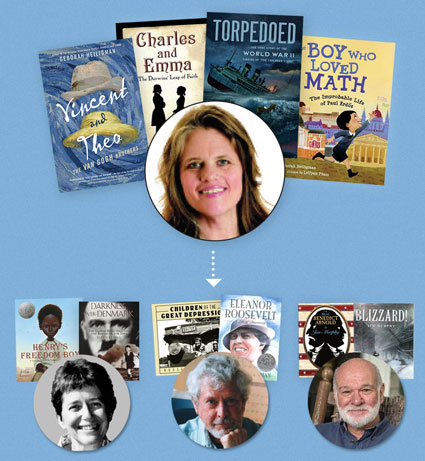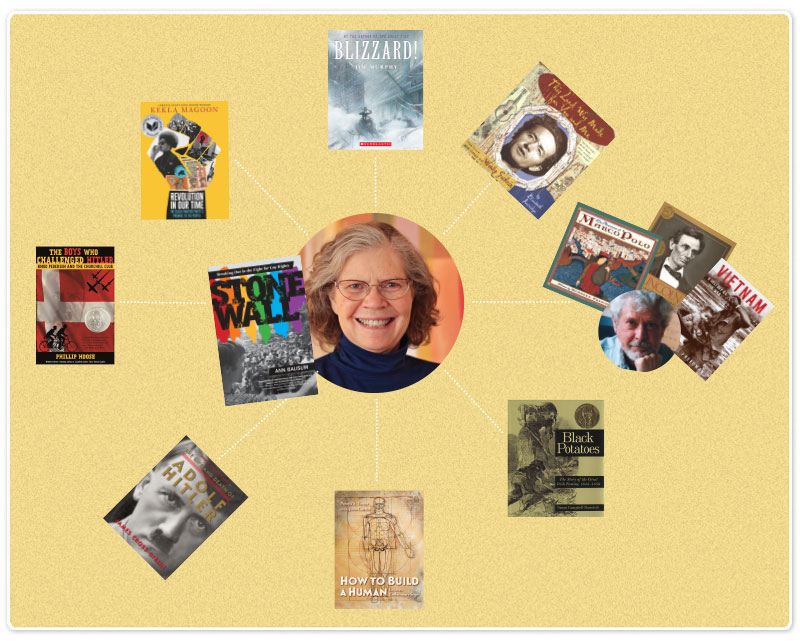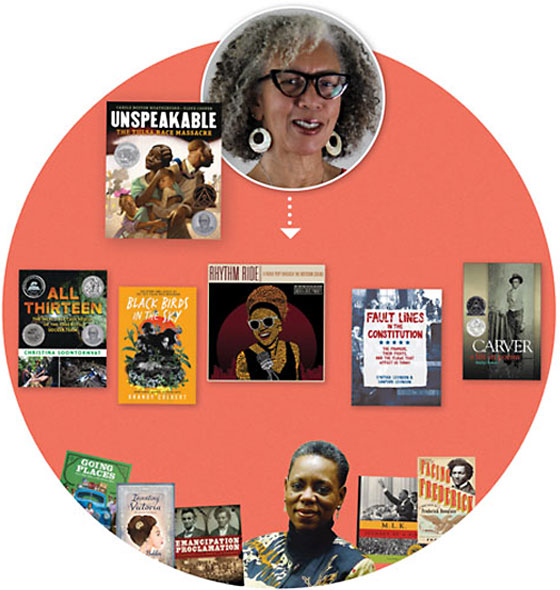 |
Author and illustrator Robin Ha (Cook Korean!) recommends “March” by John Lewis and Andrew Aydin, illus. by Nate Powell, which she calls “most influential”; Maus: A Survivor’s Tale by Art Spiegelman; Gender Queer by Maia Kobabe which “made me think critically about gender norms in our society”; and Laika by Nick Abadzis, “a great example of how you can use creative nonfiction to turn history and science into an engaging story.” |
Last summer, TIME magazine asked a panel of star YA authors what they consider the most influential YA titles to date. Of the 100 mentioned, only eight were nonfiction, including Persepolis by Marjane Satrapi, American Born Chinese by Gene Luen Yang, The 57 Bus by Dashka Slater, Stamped by Jason Reynolds and Ibram X. Kendi, and the “March” trilogy by John Lewis and Andrew Aydin, illustrated by Nate Powell.
Why so few nonfiction titles? Starting in elementary grades, nonfiction books are usually offered up to students as resources for research and report-writing, not leisure reading. Marketing efforts often align nonfiction with Common Core standards and other curriculum markers. And few young people’s book awards are dedicated to nonfiction.
Adults may have outdated perceptions of juvenile nonfiction, too. “Perhaps there is a tendency to remember nonfiction assigned in schools a few generations ago as dry and inaccessible,” says Margarita Engle, author of Enchanted Air: Two Cultures, Two Wings: A Memoir, a work in verse about growing up Cuban American during the Cuban Revolution. “Are we remembering books we didn’t enjoy reading a long time ago, or are we open-minded about the types of books offered now? Adults need to examine our stereotypes.”
 |
“First-person accounts are the gold that responsible writers search for when researching historical topics,” says Margarita Engle. Some of her favorites include Brown Girl Dreaming by Jacqueline Woodson, How I Discovered Poetry by Marilyn Nelson, Ordinary Hazards: A Memoir by Nikki Grimes, #NotYourPrincess by Lisa Charleyboy and Mary Beth Leatherdale, and An Indigenous Peoples’ History of the United States by Roxanne Dunbar-Ortiz, adapted by Debbie Reese and Jean Mendoza. |
Last year, Mary Ann Cappiello, professor of language and literacy at Lesley University in Cambridge, MA, and Xenia Hadjioannou, associate professor of language and literacy education at Pennsylvania State University Harrisburg, petitioned the New York Times to create a nonfiction best seller list for kids. More than 250 educators and librarians signed, but the Times declined, citing a lack of staff time.
Still, BookScan statistics show that children’s nonfiction sales growth outpaced that of fiction in 2020. Growing teen activism and demand for diverse books have propelled rich offerings in YA nonfiction, including narrative works such as Spies by Marc Favreau; biographies and memoirs such as We Are Not Broken by George M. Johnson; and adaptations of adult works for teen readers.
 |
Deborah Heiligman’s “early heroes” include, from left: Ellen Levine, Russell Freedman, and Jim Murphy. |
“Each year more people are writing nonfiction and doing great work. And when I say great work, I mean breaking new ground in content, original and groundbreaking research, as well as in form and style,” says Deborah Heiligman, author of Torpedoed: The True Story of the World War II Sinking of “The Children’s Ship” and Vincent and Theo: The Van Gogh Brothers. “There are also more and more books with beautiful and evocative writing on a sentence level. More people of color and LGBTQ+ folks are writing in this field, and I hope this continues and grows.”
Heiligman adds that her “early heroes” in the field of nonfiction for young people include authors Ellen Levine, Russell Freedman, and Jim Murphy.
Recent nonfiction probes narratives and events too often overlooked or stereotyped in previous treatments. From a Whisper to a Rallying Cry by Paula Yoo, for example, is a blistering true crime story about the 1982 murder of young Chinese American Vincent Chen in Highland Park, MI, by two white men.
“I think we’re more comfortable [now] telling the messy stuff, the detestable and unjustifiable…the ugly truths. That’s a tremendous and important change,” says Candace Fleming, author of fiction as well as nonfiction works, such as The Rise and Fall of Charles Lindbergh and the 2021 Sibert Award winner Honeybee: The Busy Life of Apis Mellifera, illustrated by Eric Rohmann.
Good nonfiction challenges its readers not to accept everything they read, hear, or think at face value, Fleming adds. “We don’t have to fill in all the blanks for teens or connect the dots. We present the story and then trust them to grapple with the complexities and complications, the contradictions.”
That means including more histories of marginalized voices; more books about science, technology, and the environment; and intersectionality more broadly. Recent titles include Girlhood: Teen Girls Around the World in Their Own Voices by Masuma Ahuja, a scrapbook-style book featuring journal entries and photos from teen girls across the globe; Revolution in Our Time by Kekla Magoon, showcasing the history of the Black Panthers; and Taking On the Plastics Crisis by Hannah Testa, part of a series of books for young adults by and about young activists.
“First-person accounts are the gold that responsible writers search for when researching historical topics,” says Engle, noting that memoirs have been vital to understanding history and culture. Among Latinx memoirs, she counts Francisco Jiménez’s four-book series that begins withThe Circuit, Becoming María by Sonia Manzano, and The Distance Between Us by Reyna Grande as a few of the most influential, in her view.
 |
Ann Bausum, author of Stonewall: Breaking Out in the Fight for Gay Rights cites these titles as “great works of narrative nonfiction”: Blizzard! The Storm That Changed America by Jim Murphy; This Land Was Made for You and Me: The Life and Songs of Woody Guthrie by Elizabeth Partridge; Black Potatoes: The Story of the Great Irish Famine, 1845-1850 by Susan Campbell Bartoletti; How to Build a Human: In Seven Evolutionary Steps by Pamela S. Turner; The Life and Death of Adolf Hitler by James Cross Giblin; The Boys Who Challenged Hitler: Knud Pedersen and the Churchill Club by Phillip Hoose; and Revolution in Our Time: The Black Panther Party’s Promise to the People by Kekla Magoon. Bausum calls Russell Freedman “a groundbreaker in YA nonfiction and a staple for all readers.” |
Spotlight on research
More recent nonfiction titles include a wealth of back matter, inviting readers to follow research trails and learn more about the topic—and to show the work is based on solid sources. Strong back matter has been a consideration by YALSA’s Excellence in Nonfiction Award committee for winners, including Heiligman’s Torpedoed. In their adaptation of White Rage for young adults, titled We Are Not Yet Equal, authors Carol Anderson and Tonya Bolden chose to update the back matter and tailor it to teen readers.
Gail Jarrow, author of Ambushed! The Assassination Plot Against President Garfield, which draws from primary sources such as newspaper accounts and diary entries for illustration, notes that dialogue in nonfiction has become much more accurate in recent years. “About 13 or 14 years ago, citations for direct quotes first began to appear. But even 10 years ago, the notes section was often missing from well-known books, or the citation lacked the page in the source from which the quote was taken,” she says. Now, Jarrow says, it’s much more common to see authors’ notes explain the reasons for writing the book, methods used, and additional insights about the subject.
There has also been greater consideration to books’ design and feel, with more youth nonfiction mirroring YA fiction and adult nonfiction. “The way the books are designed has changed for the better,” says Steve Sheinkin, author of historical nonfiction books including Bomb: The Race to Build–and Steal–the World’s Most Dangerous Weapon and Fallout: Spies, Superbombs, and the Ultimate Cold War Showdown. “Cool covers, less big and boxy and textbook-looking. I used to have to fight for a smaller trim size with every new book, for instance. Now that seems to be standard.”
Still, Sheinkin says, “[youth nonfiction] is still associated with school reports, textbooks, that kind of thing. It’s still seen as health food—as something you should like, as opposed to something you know you’re going to enjoy.”
Essential reading
What books do YA nonfiction authors consider must-reads? Carole Boston Weatherford, whose Unspoken: The Tulsa Race Massacre earned a Newbery honor, a Siebert honor, and was longlisted for the National Book Award, cites All Thirteen by Christina Soontornvat, Rhythm Ride by Andrea Davis Pinkney, Carver by Marilyn Nelson,Black Birds in the Sky by Brandy Colbert, Fault Lines in the Constitution by Cynthia and Sanford Levinson, and anything by Tonya Bolden.
“These authors broke new ground, either with gripping subjects or innovative tellings,” Weatherford says.
 |
Carole Boston Weatherford recommends works by Christina Soontornvat, Brandy Colbert, Andrea Davis Pinkney, Cynthia and Sanford Levinson, Marilyn Nelson, and “anything by Tonya Bolden.” |
“For me, a great work of narrative nonfiction uses impeccable research and the techniques of storytelling to create a factual book that is impossible for readers to put down,” says Ann Bausum, author Stonewall: Breaking Out in the Fight for Gay Rights. “It doesn’t matter if the topic is a familiar one or unknown; compelling writing will pull the reader in and carry them through to the last page.”
Titles Bausum puts in that category includeBlizzard! The Storm That Changed America by Jim Murphy; The Life and Death of Adolf Hitler by James Cross Giblin; This Land Was Made for You and Me: The Life and Songs of Woody Guthrie by Elizabeth Partridge; and Black Potatoes: The Story of the Great Irish Famine, 1845-1850 by Susan Campbell Bartoletti.
Like Heiligman, Bausum points to the late Russell Freedman, whose books include the Newbery winner Lincoln: A Photobiography and Vietnam: A History of the War, as a groundbreaker in youth nonfiction who produced many staples. Bausum’s favorites in recent nonfiction are The Boys Who Challenged Hitler: Knud Pedersen and the Churchill Club by Phillip Hoose, Magoon’s Revolution in Our Time, and How to Build a Human: In Seven Evolutionary Steps by Pamela S. Turner, which explores the science of human evolution in a humorous, relatable way for teen readers.
“I’m already hooked by Turner’s clever distilling of a complicated subject into seven extremely relatable categories of human development. Who wouldn’t want to keep reading when ‘We Invent Barbecue’ becomes one of those essential steps?” Bausum says.
Fleming uses a cooking metaphor to compare the process of writing fiction and nonfiction. “I liken it to baking a cake,” she says. “My goal when writing fiction is to create a scrumptious cake that my readers will gobble up. To achieve this goal, I can choose any ingredients I want. My goal when writing nonfiction is exactly the same: to create a scrumptious cake. Problem is, the ingredients have already been chosen for me. I can’t sneak in any hot fudge. Instead, I have to examine those ingredients, consider them in fresh combinations, and bake them in some surprising way.”
“I also think YA nonfiction is overlooked because people often assume that fiction is somehow ‘truer’ or more emotionally resonant than nonfiction,” she adds. “Of course, that’s nonsense. Teenagers can see themselves in nonfiction stories, especially those that have been written with them in mind.”
For author and illustrator Robin Ha, author of Cook Korean!, a successful nonfiction work utilizes the same tools as fiction: It’s a good story told in interesting and engaging ways. Among the titles she calls the most influential are “March” and Art Spiegelman’s Maus.
“Gender Queer [by Maia Kobabe] opened my eyes and made me think critically about gender norms in our society that so many of us take for granted,” she adds. In addition, Nick Abadzis’s Laika, about the dog who was the first space traveler from Earth, is “a great example of how you can use creative nonfiction to turn history and science into an engaging story.”
While there won’t be best-selling YA nonfiction on the Times list in the foreseeable future, there’s no shortage of nonfiction gems for teens looking for enthralling stories.
“Just give it a chance,” says Sheinkin. “There are lots of readers who actually prefer nonfiction.”
Kelly Jensen is the author of nonfiction anthologies, including Don’t Call Me Crazy.







